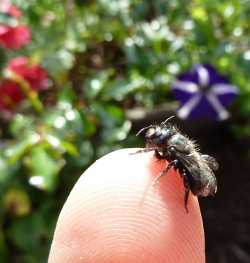Mason bee a solution to pollination woes
 Despite
“green thumb” efforts last spring, many
gardeners are reporting lackluster plant and
food production. Quite possibly, the reason was
a lack of bee pollination. There is a solution;
the diminutive, garden-friendly mason bee, a
super pollinator that rarely stings.
Despite
“green thumb” efforts last spring, many
gardeners are reporting lackluster plant and
food production. Quite possibly, the reason was
a lack of bee pollination. There is a solution;
the diminutive, garden-friendly mason bee, a
super pollinator that rarely stings. Cindi Kimball, CNP, Moose Valley Farms, explained, “Bees pollinate one-third of our food supply, which relies heavily on the troubled honey bee. We need more alternative bee pollinators. Our store is part of the movement to close the bee gap and protect our food supply. We are helping our customers create healthy garden yields by supplying gentle-natured mason bees and bee-safe products.”
Mason bees are terrific garden companions. A single mason bee efficiently pollinates 12 pounds of cherries - a task requiring 60 honey bees to achieve the same result. This 1:60 mason bee/honey bee ratio applies to other spring fruits (i.e., apples), flowering plants and nuts (i.e., blueberries).
About the size of a house fly, these amazing pollinators are very gentle and rarely sting. They team well with honey bee pollinators, but stay closer to the nest. While they don’t produce honey, they’re gardener and family friendly, making them fun to observe and easy to raise.
Cindi describes six easy steps to help gardeners successfully raise mason bees, and achieve better pollination. Get details about these steps and products from Moose Valley Farms, www.moosevalleyfarms.com, or learn more from their gentle bee partner, crown bees, at www.crownbees.com.
1. Plant nutritious, pollen-rich bee food in your garden and yard.
2. Create a safe bee “nursery” for egg laying. This includes a sheltered house that keeps nest-building material dry and safe.
3. Select safe nest-building material (tubes, reeds or wood trays). Avoid plastic and drilled holes.
4. Keep moist, clayey-mud within 50 feet of nest. Females use mud to seal each pollen/egg chamber.
5. Use fewer chemicals, and use them wisely.
6. Harvest your bee cocoons to help the bee population thrive. Overwinter in the fridge in a container.
“To close the bee gap, we need more bees each season,” Cindi said. “Harvest your cocoons and give your extra bees to other gardeners, or join the bee buy-back program sponsored by Crown Bees. They take healthy cocoons in trade for nesting materials, or cash, and then re-home them.
"By increasing the mason bee population at the gardener level, we’ll be able to later meet the demands from commercial orchards and food growers. Everyone benefits by raising mason bees.”
Moose Valley Farms is an independent, family-owned garden center, greenhouse and feed store in Naples, Idaho. Staffing Certified Nursery Professionals and a friendly and knowledgeable staff, Moose Valley Farms offers a wide variety of plants, gardening products, feed and supplies, as well as a wealth of knowledge that they love to share with the community. For further information, call
Moose Valley Farms at (208) 267-5108 or email Cindi at cindikimball@moosevalleyfarms.com.
|
WHAT MASON BEES NEED |
ACTIVITIES TO HELP BEES THRIVE |
|
Spring Garden Planning |
|
|
Pollen |
Plant pollen-rich fruit trees and flowering plants. |
|
House for bee nursery |
Select a bee house that keeps nesting material dry and safe. |
|
Nest-building material |
Create a safe bee “nursery” for egg laying. Use natural materials like tubes, reeds, or wood trays. |
|
Moist mud for babies |
Ensure there is moist, clayey mud nearby (within 50’ of the nest.) The female uses this mud to seal each pollen/egg chamber. |
|
Fewer chemicals |
Chemicals can harm bees. Be wise in using garden chemicals |
|
Fall Harvesting |
|
|
Harvest bee cocoons |
Harvest your fruit, then harvest cocoons in the fall for next season’s crops |
|
Overwinter healthy cocoons |
Store hibernating cocoons in a container in the fridge. Place them outside when your blossoms are ready to be pollinated. |